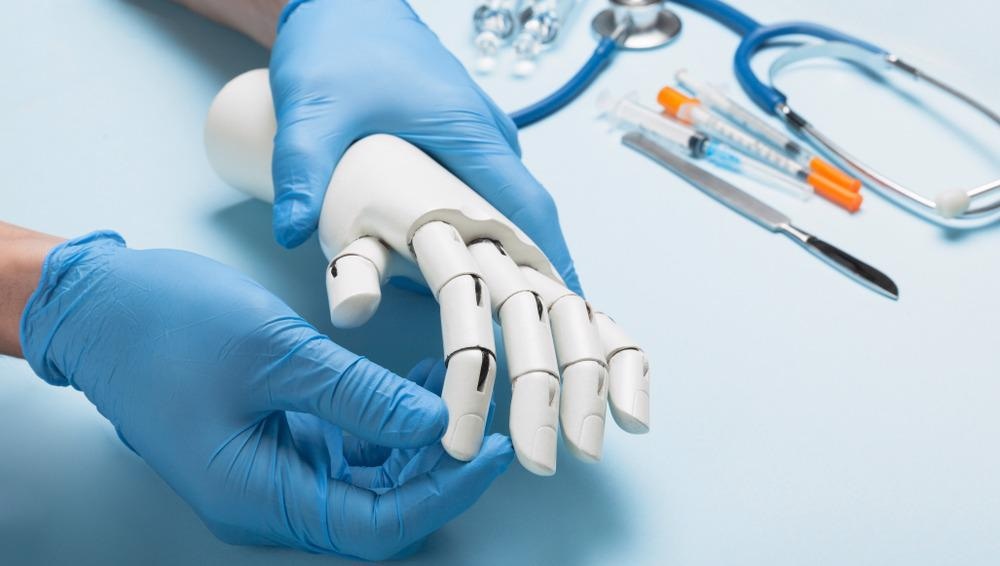Scientists in the US have used liquid metal to develop stretchable tactile sensors for use in prosthetic hands. The innovation has the potential to give a sense of touch back to amputees, something that has yet to be achieved by modern prosthetics. The new sensors may have a significant impact on the quality of life of millions worldwide, with more than 150,000 people undergoing amputation each year in the US alone.

Image Credit: Andrii Zastrozhnov/Shutterstock.com
The Development of Prosthetics, from Function to Sensory Restoration
According to the World Health Organization (WHO), around 30 million people worldwide need prosthetic and orthotic devices. In the US alone, it is estimated that 158,000 undergo amputation every year, and this number is predicted to increase.
While the loss of a limb can dramatically alter a person’s physical abilities, mental state, and ability to perform their jobs or basic daily tasks, prosthetics offer the opportunity to regain some of this lost function and restore quality of life.
The first use of prosthetics dates back hundreds of years, historians have confirmed that the fifth Egyptian Dynasty that existed between 2750 to 2625 BCE used early forms of prosthetics. Modern prosthetic use is often thought to begin with Dubois Parmlee’s invention of a prosthetic leg with a suction socket, polycentric knee, and multi-articulated foot. This was then improved in 1868 by Gustav Hermann who suggested the use of aluminum rather than steel to make prosthetics lighter.
Since then, scientists have worked on developing prosthetic limbs so that they are more functional and help patients regain a fuller range of movement as well as to serve more specific purposes, such as limbs built for athletes. This journey of prosthetic development continues and has now reached an exciting stage where function and movement have significantly advanced. Scientists are now focusing on technology that can allow amputees to recover a sense of touch via their prosthetics.
Using Liquid Metal to Develop a Sense of Touch
A team of scientists at the College of Engineering and Computer Science based at Florida Atlantic University have developed a prosthetic hand interface with stretchable tactile sensors that promise to recover a sense of touch in those who have had amputations.
There are 3,000 touch receptors in the human fingertip alone, enabling us to finely tune our movements, accomplish highly dexterous tasks, and feel a sense of connection with our surroundings. While prosthetic technology has advanced significantly over the decades, technology that recovers sensory qualities has been lacking.
In a paper published in the journal Sensors in May 2021, the Florida team detail how it has successfully incorporated stretchable tactile sensors that utilize liquid metal onto the fingertips of a prosthetic hand to generate a sense of touch that is absent from other cutting-edge prosthetics.
The team developed stretchable tactile sensors using liquid metal, encapsulated within silicone-based elastomers. In comparison to traditional sensor technology, these new sensors have higher conductivity, compliance, flexibility, and stretchability.
In a study designed to develop and test the capabilities of these sensors, scientists used the prosthetic hand’s individual fingertips to distinguish between the varying speeds of a sliding motion made along surfaces of different textures. Ridges were spaced apart at different intervals along each texture, acting as a single variable parameter to allow the texture to be distinguished from the others.
Four machine learning algorithms were trained to distinguish the different textures and speeds. A total of 20 trials were conducted on each of the 10 surfaces to test the efficacy of the four machine learning algorithms at determining the different textures. The study’s findings revealed that the integration of tactile information collected via the liquid metal sensors on four of the prosthetic hand fingertips allowed them to distinguish between complex, multi-textured surfaces, simultaneously.
Each of the machine learning algorithms proved their ability to distinguish between all variations of speed with each finger. Of the four algorithms, the neural network performed best at distinguishing speed and texture with just a single finger. The results showed the neural network operated at a 99.2% accuracy rate for distinguishing between ten different multi-textured surfaces.
While previous research has aided the development of similar tactile sensors, there remains a need for advances to be made to create sensors that are low-cost and lightweight. This research offers a possibility to produce such a sensor on a large scale.
The study’s findings move the field closer to developing a more natural prosthetic that allows its wearer to ‘feel’ the world around them, and to interact and respond to their environment in a way that previous prosthetics cannot facilitate. The new technology has the potential to restore a sense of touch to those with missing limbs and will help them to produce more fine-tuned movements.
References and Further Reading
Abd, M., Paul, R., Aravelli, A., Bai, O., Lagos, L., Lin, M. and Engeberg, E., 2021. Hierarchical Tactile Sensation Integration from Prosthetic Fingertips Enables Multi-Texture Surface Recognition. Sensors, 21(13), p.4324. https://www.mdpi.com/1424-8220/21/13/4324
Liquid metal sensors bring touch sensation to prosthetics. The Engineer. Available at: https://www.theengineer.co.uk/liquid-metal-sensors-bring-touch-sensation-to-prosthetics/
Raichle, K., 2008. Prosthesis use in persons with lower- and upper-limb amputation. The Journal of Rehabilitation Research and Development, 45(7), pp.961-972. https://www.ncbi.nlm.nih.gov/pmc/articles/PMC2743731/
Disclaimer: The views expressed here are those of the author expressed in their private capacity and do not necessarily represent the views of AZoM.com Limited T/A AZoNetwork the owner and operator of this website. This disclaimer forms part of the Terms and conditions of use of this website.